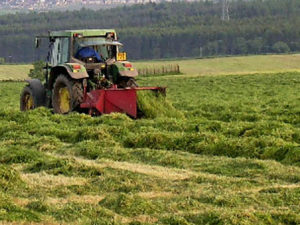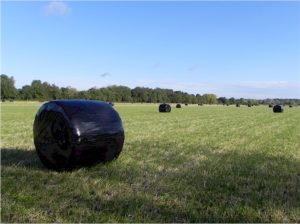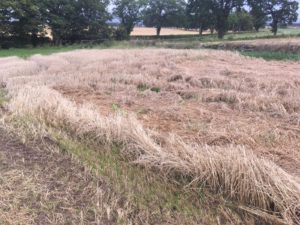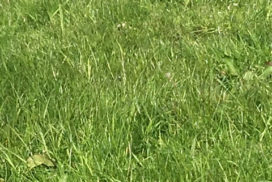Grassland and Forage
Autumn & Winter Grazing Considerations
Grazing management must always balance the livestock needs in the present with an eye on the future, this is particularly relevant through the autumn and winter. We know grazing too long through the winter will impact spring growth. Therefore, consider how you plan to optimise both the winter needs and spring production now. Read more>>
High Nitrates In Silage
Silage that has had a late application of fertiliser or that was cut during the drought conditions this summer can contain elevated levels of nitrates. This can have a direct effect on the silage quality, particularly the fermentation resulting in reduced palatability and a drop in intakes. Read more>>
Improving Baled Silage Quality; What's It Worth?
When buying or selling silage bales, nutritional value is rarely taken into account, but the variation in quality can be huge. Having an analysis to hand might allow you to command a better price if selling and the buyer is more aware of the silage quality they are purchasing and whether it is suitable for the class of stock it is destined for. Read more>>
Reducing The Environmental Impact Of Silage Bales
Baling silage is generally a more expensive way of making silage compared to clamp storage and silage quality tends not to be quite as good. As baler technology develops, the quality and quantity of silage in a bale is increasing. However, the environmental issue of plastic use and disposal remains a big concern with baled silage. Read more>>
Forage Stocktake
January is a good time to assess silage and straw stocks to ensure that you have enough to see you through to spring turnout. Take a look at what stock is currently being fed and review rations to make sure that stock are being fed appropriately. If you have not already done so then consider a silage analysis so that you can more accurately calculate your silage demand. Read more>>
Handling and Stacking Silage Bales
When making silage bales it worth taking extra care around handling, wrapping and stacking of bales to avoid costly nutrient losses and some harmful moulds that can cause issues with livestock. Read more>>
Forage Affected By Flooding
If you have had forage damaged by flooding than there are a few things you can do on farm to assess the nutritional effect and minimise the risks. A good first step is to calculate how much forage is available. You can use the FAS forage budgeting tool to assess your feed stocks https://www.fas.scot/downloads/feed-and-forage-factsheet/. As part of your forage budget it would be useful to treat damaged forage separately. To carry out an accurate forage budget you will require the dry matter of the silage. Therefore it would be worth getting an analysis done. Read more>>
Preparing For A Wet Turnout?
If the wet weather continues turnout will be delayed due to wet ground conditions and the risk of poaching etc. For flocks and spring calving herds this will put severe pressure on housing space and stock densities. Overall this will increase the risk of scour, pneumonia, watery mouth, coccidiosis etc. and increased lamb/calf losses. Read more>>
Taking A Representative Silage Sample
Poor sampling technique is one of the main causes of unreliable silage analysis results. It is important to take a representative sample of the silage which will be fed to stock. This ensures the results are reliable and accurate, in order to ration livestock as effectively as possible. Read more>>
Introducing Sheep To Barley Stubbles
Is it safe to put sheep on to barley stubbles? Barley stubbles can be a useful area to keep sheep for a period in the autumn/early winter to let grassland rest or buy more time outdoors, however there are many considerations to make. Read more>>
Harvesting Sprouted Grain
Sprouted grain only has a value as an animal feed but fortunately there is very little or no difference in its nutritive value compared with whole grain. The big problem is the higher cost of preserving it. Chitted grain will have a higher moisture content, increasing drying costs. This is likely to be further aggravated by weather forcing crops to be harvested in less than ideal conditions. Read more>>
Grass That Has Got Ahead
2019 was a great season for grass growth, however the downside is keeping on top of quality.
Those that are rotational grazing will be able to keep the rotation short (around 24 days) to maximise quality. The fields that have been taken out of the rotation can be cut for silage or hay. However, there comes a point when the cost of conserving grass is not worth. This is where deferred grazing might be an option to leave standing hay for weaned cows or ewes in mid-pregnancy. Read more>>
Ragwort Warning
Care should be taken when making silage and hay to avoid contamination from Ragwort. Ragwort has been on the increase over the last few years. Cattle and sheep are most at risk of poisoning from eating ragwort when ensiled in silage or hay but also watch out if grazing recently topped fields, especially if grass availability is tight and ragwort is drying out. Read more>>
A Summer Drought = A Shortage Of Silage?
When experincing very high levels of grass growth mean that many set stocked fields will get ahead of the cattle and need topping later next month. One simple way to avoid this is to shut off today 10 – 25% of the field with an electric fence to form a grass buffer. If it rains and grass continues to grow well the grass in the buffer can be conserved as a light bonus crop and the aftermath returned for grazing. Read more>>
Feeding Out Multiple Forages
Fodder crops vary greatly in nutritional value. They also host different benefits e.g. fodder beet achieves a high yield, kale is cold tolerant meaning it is winter hardy and hybrid brassicas can offer summer, autumn and winter grazing. Growing different forages across a field and grazing down through the mix, allows the benefits to be maximised of each individual crop, while also balancing the nutrition of the animal. Read more>>
Ergot Poisoning Identified
In winter 2018 ther was a report from a North-East Scotland suckler cow herd of ergot poisoning, with some cattle having to be put down. Although usually associated with contaminated grain, the source of ergot in this case was from late cut baled grass silage, other reports have found ergot in grass cut for silage from arable field margins. Silage associated ergot toxicity has been described previously in the UK. Risk factors include late cut silage (as seed heads develop) and wet weather. Ergot toxicity may be a risk where late cute silage has been taken, particularly following wet autumn weather. If you are feeding this type of silage/hay check now for any of the following symptoms: Read more>>
Check Brassica Grazing Stock
Remember to check the performance of sheep grazing brassicas, this can be done through regular weighing, assessing fat or condition scoring. If any sheep are not performing remove them from the brassica and instead either house or turn onto grass. Read more>>
Dry Silage and Clamp Management
The dry summer of 2018 led to an increase overall in the average dry matter (DM) of silages received into the SRUC lab. In the pit, high DM silages were more susceptible to heating and spoilage and were more likely to contain mycotoxins (for more info: https://www.fas.scot/news/mycotoxin-risk-with-high-dry-matter-silages/). If the pH is higher than 4.4, this increases the risk of spoilage which can occur very quickly. Read more>>
Beware Of Nitrate Poisoning Risk
In normal conditions, plants do not absorb so much nitrate as to cause problems in stock. However, warm overcast weather after a long dry spell, can lead to an increase of nitrogen absorption, particularly on leafy forage brassicas. A nitrate concentration above 2 g/kgDM is considered a risk. There may be a higher risk this year due to the growing conditions. Read more>>
Big Bale Kale
In addition to grazing or cut-and-cart (being a more traditional method), kale can make an effective silage crop, both in clamps but more frequently into big bales. Despite its low dry matter, providing a reasonable wilt, big bale kale silage is an adequate conservation method. Read more>>
Utilisation Of Forage Crops
There have been many people who have sown a catch crop to fill the forage gap this autumn and winter. It is essential that these forage crops are utilised appropriately to ensure maximum animal performance and utilisation of the crop. Read more>>
Calculating Daily Requirements
Calculating the daily requirement of the crop is a simple task, which is extremely beneficial to making the crop last longer, while balancing the nutritional requirements of the livestock. If livestock are given too large an area, they are prone to eating all leaf material (high in protein) and then going back to the bulb (high in energy). This also results in wastage of the crop from trampling. Read more>>
Managing Valuable Fodder
Trusting in a kind autumn or early spring to shorten the housing period is an option but it needs to be done consciously to gauge exposure to more expensive feed prices, damaging grass-leys, affecting cow body condition or youngstock growth rates. Read more>>
Capturing Rainfall After Drought
When rain is forecast, how can we divert the water into the soil rather than letting it run over the soil surface?
Soils are likely to head from very hard back into a more friable (workable state) at some point in the near future, providing a window of opportunity to aerate soils which is worth being prepared for. Not all compaction built up over successive wet seasons will have been alleviated by this prolonged dry spell, during the summer of 2018. Read more>>
Giving Grass A Rest
Winter grazing management influences the quality and quantity of grass in the spring. The difference was quantified in the 1970’s in John Frame’s research; sheep grazing in a set stocked system from October to December reduced April yield by 31% and sheep grazing from January to March reduced yield by 40%.
Farms that winter all stock inside will see this; the grass, following a break, gets going quicker in the spring as it has the leaf area to capture sunlight. Clearly, this is expensive, so what are the other options? Read more>>
Forage Budgeting
In summer 2018 there were reports of farmers currently having 25-40% less silage than normal and some cattle who are already eating into that supply, to buffer performance, it is extremely unlikely that the higher dry matter forage will fully compensate for the lack of volume.
It is always a good idea to measure how much forage you have available for the winter period to allow you to make provision. Read more>>
Managing Grassland After A Drought
During the drought (summer 2018) some fields have been grazed and others shut off in the hope of a possible second cut etc. Where grass has been grazed, either by set stocking or rotational grazing, the lack of moisture has forced it to continually draw on it’s root reserves and deplete them.
For fields which have been shut up, where the drought has been severe the grass has gone very much into survival mode and, after having produced a couple of small leaves, gone to seed. Read more>>
Dip In Summer Growth
Grass is a great asset for feeding and when managed well can produce high liveweight gains from cattle. However, as we move through summer it is important to remember that grass will start to become more fibrous, therefore reducing the metabolisable energy (ME), potentially to around 11 MJ/kg DM. This can support gains of around 0.8kg/day; however it can be extremely variable; being potentially much lower in fields that have been affected by drought. Read more>>
Prolonged Dry Weather On Grass
The heatwave that we experiencing in 2018 won’t in itself restrict the growth of the principal grass i.e. ryegrasses. In fact, their optimum growth temperature is 25 C. The main issue is lack of soil water.
This is exacerbated in continually grazed swards where the grass rooting depth is severely restricted by continual loss of leaf material. Read more>>
Short Of Forage - Poor Cereal Crops?
The traditional way of harvesting cereals for livestock was arable silage which was harvested when the grain reached the cheesy ripe stage in late July. This did produce high yields but a moderate feed quality making it really only suitable to dry spring calving cows. The other problem with it was its attractiveness to vermin and hence baling arable silage was not particularly successful due to the damage to the wrap. Read more>>
How High To Cut For Silage?
Many producers are talking about going for bulk with their first cuts this year to replenish, as much as possible, empty silos etc. A common thought would be to –
- Delay cutting by 1 or 2 weeks and
- Mow as close to the ground as possible.
Surging Grass Growth
When all of a sudden, the grass is growing at a rate of knots. Reacting quickly will improve utilisation and help maintain quality for the summer.
Those on rotational grazing might consider taking some fields out of the rotation now to decrease rotation length. Often we quote a 21 day rotation in the spring, i.e. giving the grass a 21 day rest before re-grazing. Read more>>
Fast Forage Options
With the inevitable lower yield of grass in years where we have suffered a delayed spring, the pressure to get lambs growing and away is ever greater to preserve forage supply going into the winter. In addition, there is no doubt some fields need attention. This could be an opportunity to establish some short term, fast growing grasses in order to fill the forage gap in the back end. Read more>>
Fodder Beet
Fodder beet is a root crop of great interest in the ruminant nutrition world due to its huge potential as a high yielding, high energy winter forage. Fodder beet is a versatile crop with can be grazed in situ or harvested mechanically and fed elsewhere. If you are considering sowing fodder beet this year there are some nutritional aspects to bear in mind: Read more>>
Coping With The Bad Weather
- Feed potatoes to grazing stock
- Supplementary feed stock outside
- Begin creep feeding as soon as possible
When Will Spring Time Come?
Nobody knows when spring will come and so it is wise to prepare for a delayed turnout so calculating feed and bedding supplies is best now.
In many farms forage supplies will be limited. Simply get your forage analysed so alterations can be made to diets which may help stretch out the supply. Read more>>
Sulphur For Grass And Crops
Historically, in the UK sulphur was deposited on land from the atmosphere in quantities which were adequate for our crops, but today very little sulphur lands on our fields. As a result, applications of sulphur to crops has become an essential part of nutrient management planning. Read more>>
Grass Availability
It is best to check sward heights on a regular basis to ensure there is adequate feed for them. The table below is a guide to grass heights for cattle at grass. Other factors such as quality of grazing, stocking rates and weather will also need to be taken into account. Read more>>
Sign up to the FAS newsletter
Receive updates on news, events and publications from Scotland’s Farm Advisory Service































